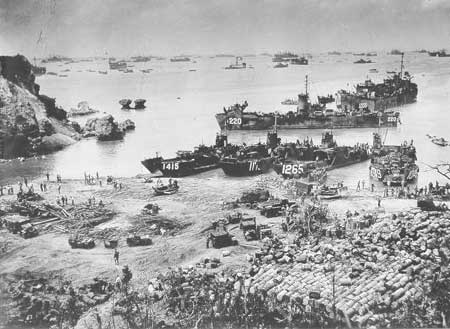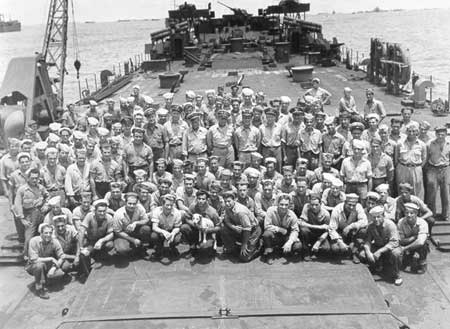| The War in the Pacific |
|
|
Okinawa The Coast Guard's final major amphibious action was at Okinawa. Operation Iceberg proceeded along the same successful formula that other Allied invasions had taken. Carrier aircraft and surface ships shelled and bombed the island for nine days prior to the landings. The Coast Guard had a total of 53 ships that participated, and another six with partial Coast Guard crews accompanied the invasion forces. These transports, cargo vessels, amphibious force flagships, and more than 40 LSTs and LCIs formed part of the overall force of more than 1,400 vessels carrying more than 548,000 soldiers, sailors and Marines.
The amphibious task force arrived off the beaches on Easter morning, April 1, 1945. The Japanese chose not to defend the beachhead. Therefore the greatest initial threat faced by the attacking force was Kamikaze attacks. During these attacks a suicide plane struck the Coast Guard-manned LST-884. The plane plowed through the shipfitter's shop and into its cargo of ammunition. Racked by fire and explosions, the commanding officer ordered all hands to abandon ship, but the attack had cost the lives of 24 men. The beachmasters and their men waged their own battle with an unseen enemy. The coral off the beaches at Okinawa complicated the unloading of supplies. The LCVPs and LCMs had only six hours a day, near high tide, to unload the craft. Due to the tremendous needs of the campaign the beachmasters found it necessary to unload as many of the craft at high tide, pile the supplies on the beach, and then move the material inland at low tide. This kept the transports at anchor for a long period of time and offered the Kamikaze pilots, suicide boats and torpedo craft ample time to strike at the fleet.
The Coast Guard remained active with the amphibious forces until the surrender of Japan. Afterwards the cutters performed various operations with the occupation forces including mine-sweeping activities. The Coast Guard transports finished their major work in the Pacific by transporting thousands of men home in the "Magic Carpet" trips. The Coast Guard made a tremendous contribution to the war effort as part of the amphibious forces in the Pacific. The men of this nation's smallest military service proved as heroic and valiant as the men in the other branches. When the Coast Guard was returned to its peacetime role in 1946, Secretary of the Navy James Forrestal stated that during the war the Coast Guard "earned the highest respect and deepest appreciation of the Navy and Marine Corps. Its performance of duty has been without exception in keeping with the highest traditions of service." |


